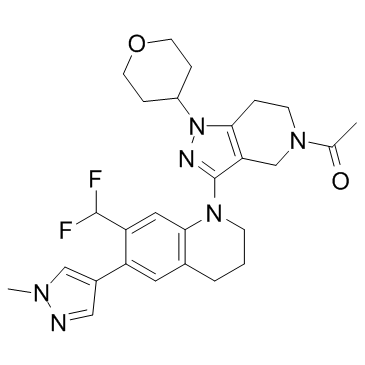| Description |
GNE-049 is a highly potent and selective CBP inhibitor with an IC50 of 1.1 nM in TR-FRET assay. GNE-049 also inhibits BRET and BRD4(1) with IC50s of 12 nM and 4200 nΜ, respectively.
|
| Related Catalog |
|
| Target |
IC50: 1.1 nM (CBP), 12 nM (BRET), 4200 nΜ (BRD4(1))[1]
|
| In Vitro |
GNE-049 is selected for further profiling as it has the best balance of liver microsomes (LM) stability, selectivity, and cellular potency GNE-049 has excellent potency in the BRET cellular assay and, in an orthogonal measure of the target engagement, GNE-049 is shown to inhibit the expression of MYC (MV4-11 cell line) with an EC50 of 14 nM[1].
|
| In Vivo |
GNE-049 demonstrates acceptable PK in mouse, rat, dog, and monkey. Determination of potency versus a selection of bromodomains revealed that GNE-049 is selective for CBP/P300 and, importantly, quite selective (3820-fold) over BRD4(1). GNE-049 is further evaluated in a rat single dose (30-250 mg/kg QD) toxicokinetic study. Adverse central nervous system (CNS)-related signs (e.g., marked hyperactivity and vocalization) are observed in several of the rats at the 250 mg/kg dose level. Furthermore, at the 250 mg/kg dose level, the ratio of the unbound drug concentration in brain to unbound drug concentration in plasma (Kp,uu) 3 h post dose is determined to be 0.43, indicating that GNE-049 is penetrating into the CNS and potentially resulting in the observed toxicity[1].
|
| Animal Admin |
Mice[1] Twelve female CD-1 mice are used. All animals are 6-9 weeks old at the time of study and weighed between 20 and 35 g. Animals (n=3 per dosing route) are dosed with GNE-049 or GNE-781 at 1 mg/kg iv (in propyl ethylene glycol 400 (35% v/v) and water (65% v/v)) or 5 mg/kg po (suspended in 0.5% w/v methylcellulose, 0.2% w/v Tween 80). Food and water are available ad libitum to all animals. Serial blood samples (15 μL) are collected by tail nick at 0.033, 0.083, 0.25, 0.5, 1, 3, 8, and 24 h after the intravenous administration and 0.083, 0.25, 0.5, 1, 3, 8, and 24 h after the oral administration. All blood samples are diluted with 60 μL of water containing 1.7 mg/mL EDTA and kept at -80 °C until analysis[1]. Rats[1] Twelve male Sprague-Dawley rats are used. All animals are 6-9 weeks old at the time of study and weighed between 200 and 300 g. Animals (n=3 per dosing route) are dosed with GNE-049 or GNE-781 at 1 mg/kg iv (in propyl ethylene glycol 400 (35% v/v) and water (65% v/v)) or 5 mg/kg po (suspended in 0.5% w/v methylcellulose, 0.2% w/v Tween 80). Food and water are available ad libitum to animals in the iv groups. Animals in po groups are fasted overnight and food withheld until 4 h postdose. Approximately 250 μL of blood are collected via the catheter at 0.033, 0.083, 0.25, 0.5, 1, 2, 4, 8, and 24 h after the intravenous or oral administration. All blood samples are collected into tubes containing 5 μL of 0.5 M K2EDTA and processed for plasma. Samples are centrifuged (2500g for 15 min at 4°C) within 1 h of collection, and plasma samples are kept at -80 °C until analysis[1].
|
| References |
[1]. Romero FA, et al. GNE-781, A Highly Advanced Potent and Selective Bromodomain Inhibitor of Cyclic Adenosine Monophosphate Response Element Binding Protein, Binding Protein (CBP). J Med Chem. 2017 Nov 22;60(22):9162-9183.
|
